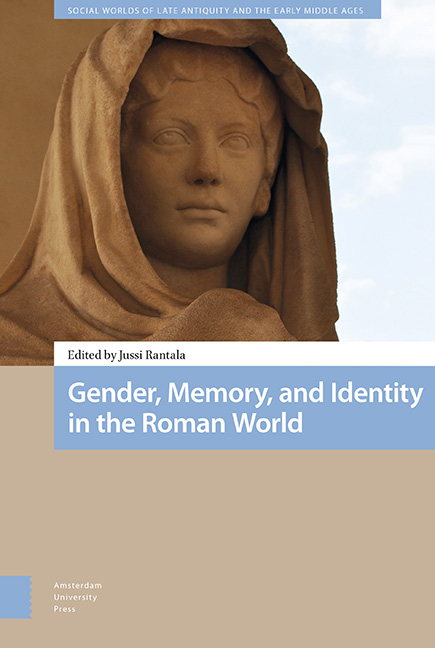Book contents
- Frontmatter
- Contents
- List of Illustrations
- Abbreviations
- Preface
- Tabula Gratulatoria
- Introduction
- 1 Public Agency of Women in the Later Roman World
- 2 Religious Agency and Civic Identity of Women in Ancient Ostia
- 3 The Invisible Women of Roman Agrarian Work and Economy
- 4 ‘Show them that You are Marcus’s Daughter’
- 5 Defining Manliness, Constructing Identities
- 6 ‘At the Age of Nineteen’ (RG 1)
- 7 Conflict and Community
- 8 Dress, Identity, Cultural Memory
- 9 The Goddess and the Town
- 10 Varius, multiplex, multiformis – Greek, Roman, Panhellenic
- 11 Mental Hospitals in Pre-Modern Society
- Index
8 - Dress, Identity, Cultural Memory
Published online by Cambridge University Press: 20 November 2020
- Frontmatter
- Contents
- List of Illustrations
- Abbreviations
- Preface
- Tabula Gratulatoria
- Introduction
- 1 Public Agency of Women in the Later Roman World
- 2 Religious Agency and Civic Identity of Women in Ancient Ostia
- 3 The Invisible Women of Roman Agrarian Work and Economy
- 4 ‘Show them that You are Marcus’s Daughter’
- 5 Defining Manliness, Constructing Identities
- 6 ‘At the Age of Nineteen’ (RG 1)
- 7 Conflict and Community
- 8 Dress, Identity, Cultural Memory
- 9 The Goddess and the Town
- 10 Varius, multiplex, multiformis – Greek, Roman, Panhellenic
- 11 Mental Hospitals in Pre-Modern Society
- Index
Summary
Abstract
In this article, the identities of female workers in bars and inns of the Roman Imperial Era are discussed on the basis of material culture – dress, appearance and jewellery – read as layers of signs referring to social status and as carriers of cultural memory. Literary and iconographic sources show that the basic garment worn both by the hostesses and the barmaids was a long tunic. Some exceptional accessories, functioning as ‘flashbacks’ of cultural memory, refer back to luxurious Greek banquets or Oriental soundscapes, and can signal meretrician side activities. The jewellery found in Pompeian thermopolia show considerable variety, ranging from a few bronze rings, bracelets or faience beads to complete parures of gold jewels.
Keywords: cultural memory, dress, jewellery, Roman bars, gender, prostitution
Introduction
Flute-girls, bearded Celtiberians, runaway slaves, mantled Greeks, and drunken priests of Cybele: Roman cauponae and popinae were places for variegated encounters, and, as such, intriguing subjects for Latin poets and satirists. Bars and inns of the Roman Empire have likewise been a fruitful subject for much recent research, as loci for mingling different social, economic, and gender categories, at the crossroads of local and foreign, private and public, moral and immoral. The identities of women working in such an environment as hostesses (copa, caupona, domina cauponae) or waitresses (ancilla, ministra), with statuses ranging from freeborn and freedwomen to foreigners and slaves, are highly interesting, because they are located ambiguously in a grey zone between Roman social categories.
In this paper, the identities of women working in bars and inns will be examined through their dress and appearance. Roman clothing was profoundly meaningful and hierarchical, full of biographic details relative to gender, age, marital status, wealth, and morals. In Barbara Kellum's words, a Roman ‘was what he appeared to be’. As a system of signs, the dress was a boundary marker between different social classes and ethnic groups. Nathan Joseph's idea that dress is made up of a series of layers of signs, more or less perceptible by others, is fundamental for the theoretical basis of the present study, together with the concept of cultural memory.
- Type
- Chapter
- Information
- Gender, Memory, and Identity in the Roman World , pp. 203 - 238Publisher: Amsterdam University PressPrint publication year: 2019



